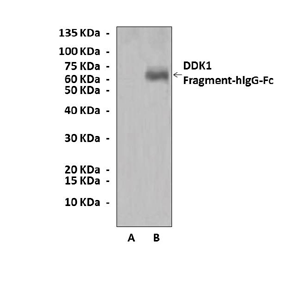Anti-DKK1: Mouse Dickkopf 1 Antibody |
 |
BACKGROUND DKK1 is a member of the dickkopf family. It is a secreted protein with two cysteine rich regions and is involved in embryonic development through its inhibition of the WNT signaling pathway.1 Wnt ligands bind to the seven-transmembrane receptor, Frizzled, and the coreceptor lipoprotein-related protein 5 and 6 (LRP5/6). DKK1 forms a ternary complex with LRP5/6 and another receptor, Kremen, followed by endocytosis of this complex and removal of LRP5/6 from the cell surface. In addition to this extracellular link, there is another novel intranuclear link between Wnt signaling and its antagonist, DKK1. It was demonstrated recently that DKK1 expression can be upregulated via beta-catenin/TCF. Thus, DKK1 may participate in a novel negative feedback loop in Wnt signaling.2 In the adult, DKKs are implicated in bone formation and bone disease, cancer and Alzheimer's disease. Elevated levels of DKK1 in bone marrow plasma and peripheral blood are associated with the presence of osteolytic bone lesions in patients with multiple myeloma.3
REFERENCES
1. Glinka, A. et al: Nature 391;357-62, 1998
2. Niida, A. et al: Oncogene 23:8520-26, 2004
3. Li, J. et al: Bone 39:754-66, 2006
2. Niida, A. et al: Oncogene 23:8520-26, 2004
3. Li, J. et al: Bone 39:754-66, 2006
Products are for research use only. They are not intended for human, animal, or diagnostic applications.
Параметры
Cat.No.: | CP10071 |
Antigen: | Purified recombinant human DKK1 fragment-hIgG-Fc fusion protein expressed in HEK293 cells. |
Isotype: | Mouse IgG2b |
Species & predicted species cross- reactivity ( ): | Human |
Applications & Suggested starting dilutions:* | WB 1:1000 IP n/d IHC n/d ICC n/d FACS n/d |
Predicted Molecular Weight of protein: | 29 kDa |
Specificity/Sensitivity: | Detects DKK1 proteins without cross-reactivity with other family members. |
Storage: | Store at -20°C, 4°C for frequent use. Avoid repeated freeze-thaw cycles. |
*Optimal working dilutions must be determined by end user.
Документы
Информация представлена исключительно в ознакомительных целях и ни при каких условиях не является публичной офертой








